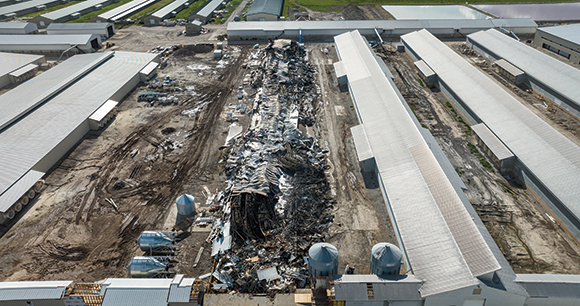In January, AWI released the third edition of Barn Fires: A Deadly Threat to Farmed Animals, chronicling farmed animal casualties in barn fires from 2022 through 2024. In the 300+ barn fires reported during this three-year period, more than 2.5 million animals suffered terrible deaths. Illinois, Minnesota, and Delaware had the highest number of casualties, while New York and Wisconsin had the most fires (31 each).

As in previous years, the overwhelming majority of barn fire victims were chickens, and huge fires at mega facilities accounted for a large percentage of the death toll. In 2024, for example, 1.2 million hens died in a single blaze at an egg operation in Illinois. It was the deadliest barn fire in more than a decade and accounted for approximately 80 percent of the total deaths for the year. Of the 10 deadliest fires from 2022 through 2024, nine occurred at facilities housing chickens.
There are no federal laws in the United States specifically designed to protect farmed animals from barn fires. However, the National Fire Protection Association has developed NFPA 150, Fire and Life Safety in Animal Housing Facilities Code—a set of standards that states could adopt. The 2025 edition of NFPA 150 requires medium- and large-sized commercial facilities that are newly built or undergoing major construction to install sprinkler systems, unless exempted by a local fire authority. This is a new requirement that AWI (which has a seat on the NFPA’s Technical Committee on Animal Housing Facilities) helped secure despite multiple attempts by industry groups to have the provision removed.
NFPA 150 only takes effect, however, if a state adopts a specific edition of the code, and to date, none have adopted the 2025 edition. (Only five states, in fact, have adopted earlier versions of NFPA 150.) During the coming year, AWI will urge more states to adopt these comprehensive safety standards that could spare untold numbers of farmed animals from suffering horrific deaths in fires.